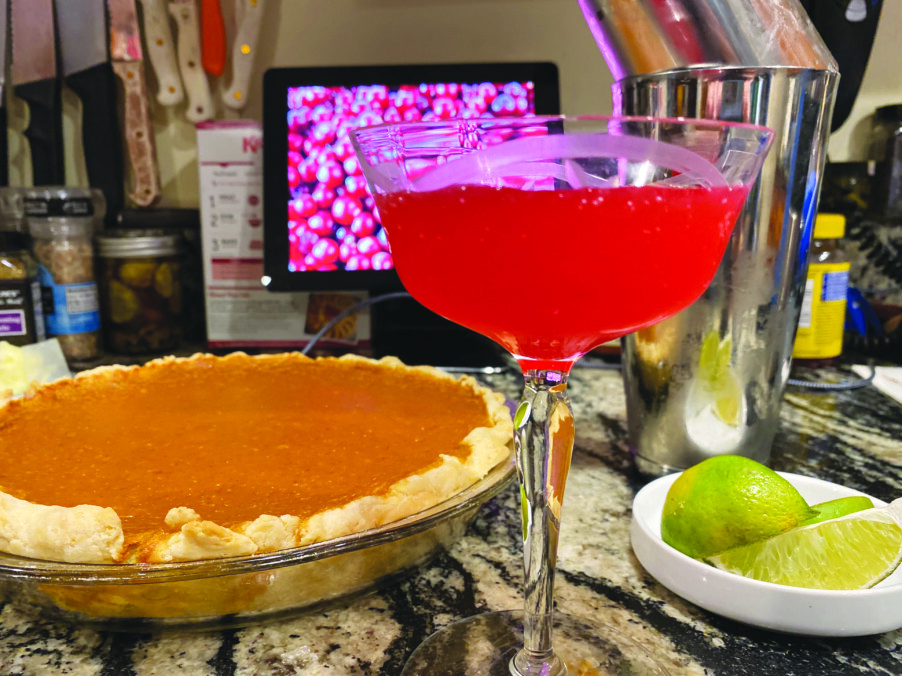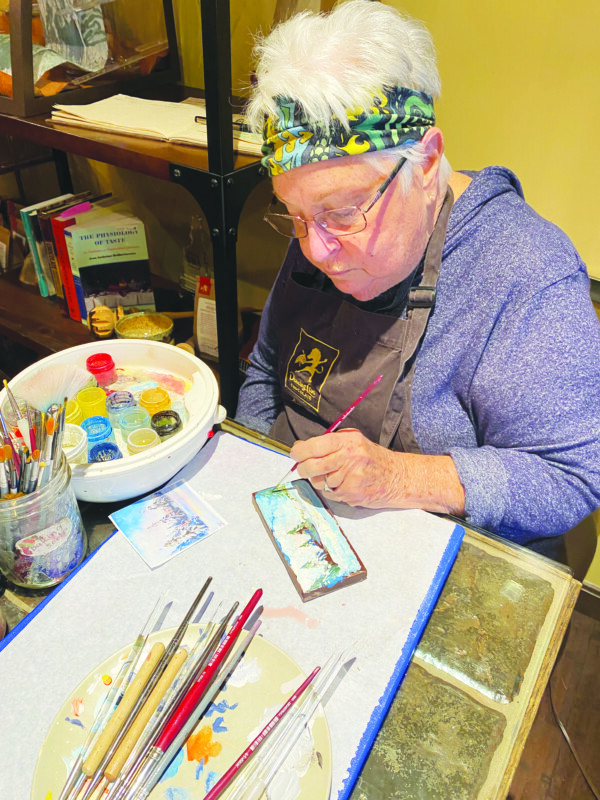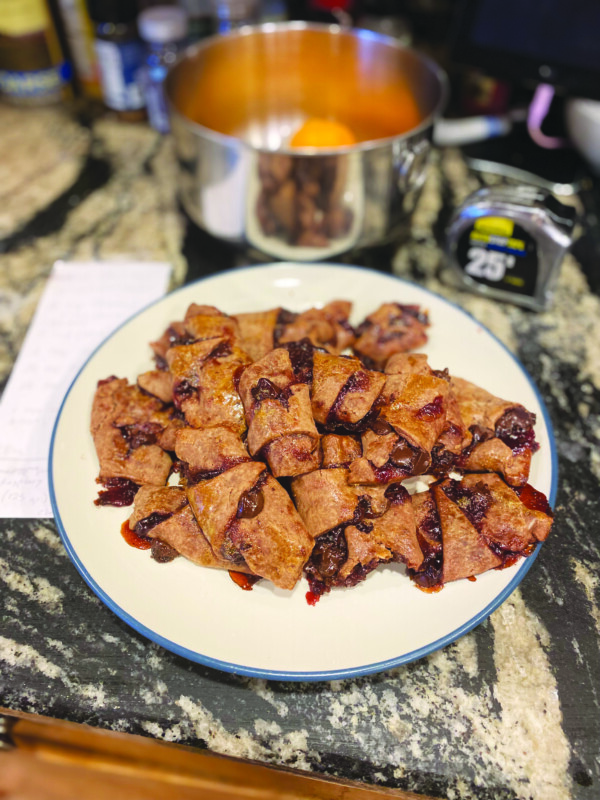The perfect buttery, sweet and savory popcorn treats for your movie nights and TV binges
Angie Lane spends a lot of time thinking about popcorn.
Lane is the Director of Red River Theatres in Concord. It’s not an overstatement to say that popcorn is the lifeblood of any movie theater, and Lane takes it very seriously. Right now, during the busy holiday season, Red River uses up a 50-pound bag of unpopped popcorn seed every day and a half or so. For Lane, the secret to really good popcorn is real butter.
“We use anhydrous butter; the water has been removed,” she said, “so it’s shelf-stable, but it’s real, actual butter.”
(Sadly, one of the cold, harsh realities of life is that the “butter” on most theaters’ popcorn is actually mostly partially-hydrogenated soybean oil, an industry salt called “Flavacol,” beta carotene — the same vitamin that makes carrots orange — for color, tertiary butylhydroquinone — a preservative — and polydimethylsiloxane, an anti-foaming agent.)
While it is real butter (minus the water), Red River’s butter isn’t something you can buy off the shelf. “One time we ran out of butter during like Barbenheimer,” Lane said, “and actually during Wicked we’ve run out of butter because there was some supply chain issue, and somebody said, ‘Oh, we can just get butter from the supermarket!’ I had to tell them that I didn’t want to kill anybody, because [supermarket butter] is not shelf-stable once you heat it up and everything. But I love it when we run out of butter. It’s an indicator that business is good.”
According to Lane, only amateurs dump the butter on the top of a tub of popcorn. “We personally layer the butter because we’re professionals,” she said. “But I love it when people ask for extra butter, because people come to the theater for the movies but they also come for the popcorn.”
“Historically speaking,” Lane said, “there’s just something about when you smell popcorn in the movie theater, like it just goes together, and I think … if you ask someone to think about a concession item at a movie theater, the first thing they would say is popcorn.” She remembers the classic intermission cartoon that used to encourage movie-goers to buy concessions. “With the little marching concession people, it’s always led by a little popcorn guy,” she said. “When you were a kid, wasn’t popcorn magical?”
Meredith Thomas spends most of her day thinking about popcorn, too. She and her husband, Ken, are the owners of Ken’s Corn in Derry, a family business that sells popcorn at farmers markets, fairs and events and through a few small retail stores. Like many small food businesses, theirs started with a face-to-face relationship with customers. ”We started at farmers markets and fairs and events,” she said. “And that’s still primarily where we meet our customers.”
The business has expanded over the past two years. “It is a year-round business,” Thomas said. “We are primarily busy from about April through Jan. 1. And then we kind of take a few months to regroup. This year we’re going to be focusing on looking at more storefronts to get into just to keep expanding.”
One of the things Thomas likes about popcorn is how versatile it is.
“We started in 2022 just making buttered [popcorn] and kettle corn as our base,” she said. “Now we have seasonal ones, like in the fall. One of those is Caramel Choco — it tastes like a Twix bar! Now, we have a Cookie Explosion, which is like cookies and cream. And one of our savory flavors is a white cheddar.”
Thomas said that coming up with new flavors comes easy to her. “I am ADD, so my brain is constantly running. But just going into a store and looking around — at even just candies or potato chips [is inspiring]. Sometimes our customers give us really great options. We’ve had a lot of requests lately for a dill pickle [flavor], so that’s on our winter menu.”
Home cooks have a natural knack for personalizing popcorn, she said.
“Before we started this business, one of my favorite snacks was to pop popcorn, either on the stove top or just the microwave bags. And then I always added pretzels and M&M’s to it, so you get that sweet and salty flavor.”
It’s easy to understand why people love popcorn so much, Thomas said. “It is a quick, easy, on-the-go snack. Young, middle-class America is constantly on the go. So they’re looking for a healthy, consumable snack that they can either eat where they are or take it on the go, running to sporting events or going to work. It also is an allergy-friendly snack, which can be hard to find. It’s gluten-free, and depending on the flavor, dairy-free and nut-free.”
Popcorn experts
Red River Theatres (11 S Main St., Concord, 224-4600, redrivertheatres.org) shows movies seven days a week. Visit the website for listings.
Ken’s Corn (68 Chester Road, Derry, 208-661-0282, kenscorn.com) is available through small stores, including East Derry General Store (50 E. Derry Road, Derry, 432-5302, eastderrygeneralstore.com) and Prime Butcher 201 Route 111, Hampstead, 329-7355, primebutcher.com).
Popzup Popcorn (Canal Street Mill, 22 Canal St., Suite 358, Somersworth, 314-8314, popzup.com) sells five flavors of popcorn, poppers, seasonings and more online and in grocery stores nationwide.
The Burstin’ Kernel (facebook.com/theburstinkernel) makes hot, fresh kettle corn on the spot at farmers markets and events throughout southern New Hampshire. The Hallinans also have a new food truck, Chew ‘N’ Screw. Check for availability and more at facebook.com/chwnscw.
Julie Lapham has been in the popcorn game even longer. She is the CEO and co-founder of Popzup Popcorn in Somersworth. She and her husband started their company in 2015. For them, making popcorn is an expression of some deeply-felt values.
“Our facility is located in an old, refurbished mill on the river,” Lapham said. “That sort of reflects who we are in terms of our mission to be local and just to do the right thing, which basically is really fresh, farm fresh, pure and simple local ingredients, make it all ourselves, be sustainable, take good care of our employees, and give back to the community.”
PopzUp produces five flavors of popcorn for retail sales online and through supermarkets, but for the Laphams, selling popcorn and making it are intertwined.
“We also sell locally grown, non-GMO popcorn kernels in a microwave popcorn popper that we actually invented ourselves,” she said. “It’s called the PopzUp Popper, which is where we came up with our name. And basically it’s a reusable microwave popping box. It’s made from virgin paperboard and it’s printed with vegetable inks. It’s, you know, totally chemical-free and … reusable and sustainable.”
Like Angie Lane, Lapham is a big believer in real butter and dairy products. “What really differentiates us from other popcorn brands,” she said, “is that we use a lot of real butter, real cheddar. There really aren’t any other commercially available brands that use pure dairy. A lot of them have butter or cheddar or whatever, but for the most part they’re ultra-processed foods, which [are referred to as] UPF. It’s an actual term; all it means is that they are not real farm fresh dairy products. [Fresh dairy] is very much more difficult to work with and to protect because it goes bad quickly. Real butter and real cheddar and real truffles are very sensitive to light and heat and air. So we have to spend more to protect them and so those are more expensive.”
Using sensitive ingredients involves putting a lot of thought into PopzUp’s packaging. The bags, for instance, are completely light-proof. “It’s actually a foil-lined bag,” Lapham said, “We really need to have that foil liner to protect the popcorn. We also do something called a nitrogen flush, which basically is right before we close the bag up and seal it, we flush it with nitrogen, which is just an inert gas. It’s heavier than oxygen, and oxygen will cause popcorn to go bad and dairy to go bad, so we have to get that out of the bag, and seal it up tight. That’s just an extra effort that we go through to make sure that our popcorn is delicious when somebody buys it. “
For a family business, PopzUp produces a lot of product.
“We go through about 10,000 pounds [of popcorn] every three weeks,” Lapham said, “which is basically four full pallets at this point. But every year it’s more and more.” Early on, the Laphams decided to take a hands-on approach with their popcorn. Instead of using automated air poppers, which is the standard in the industry, “Ours is made the old-fashioned way,” she said, “but basically on a commercial level. We have giant, real kettles that pop it, and then we take that and then we put it in giant tumblers where people put the seasoning on it and tumble that, and then we take that out and put that in a machine that helps us to ensure that the right amount goes in every bag.”
In the beginning, Lapham said, their focus wasn’t on producing seasoned popcorn.
“What we did is we let our customers tell us what the fan favorites were. We took those seasonings and that’s what we used to season the popcorn that we started selling already seasoned. The first year was really spent deciding what flavors were the best flavors, what flavors the customers liked. We started with four flavors: butter, cheddar, and then two vegan flavors, Cheesy Herby, which is made with nutritional yeast and herbs and spices, and then Maple Cinnamon Toast, which has like a kettle corn flavor but it’s not candy coated, so it’s nice and snackable — it’s got this light sweet and salty mapley flavor that you can eat a whole bag of and it’s not like you’ve eaten badly. Last year we added a fifth. We added the truffle butter flavor; we buy real Italian black truffles and mix them with our butter and then put that on.”
Given how many varieties of popcorn are available, one or two types are perennial favorites. Kettle Corn enthusiasts are especially enthusiastic. Sean and Samantha Hallinan devote themselves to it. The Hallinans own and run The Burstin’ Kernel. For the past two years they have made and sold kettle corn at farmers markets and events throughout southern New Hampshire. “We pretty much operate from springtime all the way through until December, when it just gets too cold,” Sean Hallinan said.
The Hallinans are particular about the variety of corn they use. “Basically you have different types of kernels,” Sean said, “”and some kettle corn companies use one type versus another. We use a popcorn kernel that creates a very large pop; it’s called a ‘mushroom’ style.”
Hallinan said the actual popping process is pretty straightforward.
“Basically, you throw [the kernels] in a kettle with some oil. The kettle we use is 160 quarts. It is a pretty large commercial unit. Then you throw sugar in, and stir it. We stir it by hand usually; we use a big wooden paddle to stir it, or for larger events we stir it with an automatic stirrer. When it’s done, you dump it out of the kettle and you sift it through a sifting bin and salt it or put whatever flavorings on it. The sifting removes all the kernels and small bits. We try our best to get rid of them. You don’t want people breaking their teeth on hard kernels that didn’t pop.”
Kettle corn satisfies several cravings at once, Hallinan said. “I think people like the sweet and salty mix. We try our best to get the best recipes so that way it’s not too much one way or the other. There’s also a little bit of crunch to it as well, but not too sticky, so it doesn’t get stuck in your teeth like caramel corn.”
According to Hallinan, making good kettle corn didn’t have a steep learning curve.
“I saw someone doing it and got interested in it,” he said. “and then we worked on our own recipe over and over again for, I don’t know, it probably took us maybe a week or so of trying different things until we got it just right.”
Given how much care and technique the Hallinans put into making popcorn during the day, their own popcorn consumption is pretty basic. “We kind of grew up on microwave popcorn,” he said, “so that’s our default — easy, throw it in the microwave.”
Making good popcorn at home
Kristen Chinosi is the owner of and an instructor at The Culinary Playground in Derry. According to her, a good batch of popcorn starts with the oil it’s cooked in.
“I always pick a heavy-bottomed pot, and I like to use coconut oil,” she said. “It gives it a little bit of different flavor, though, so you can really use an oil that you prefer the flavor of, whether it’s a vegetable oil or an olive oil. You just have to watch how hot you have it because some of those oils have a lower smoke point.” (This means that different oils burn at different temperatures. Refined peanut or canola oils, for instance, have a high smoke point, which means they can be heated to a high temperature before they start to break down. Extra virgin olive oil and butter have low smoke points; they burn easily.)
Chinosi heats her oil before adding popcorn kernels to it.
“I like to get my oil nice and warmed in the bottom, and I’ll put a couple pieces of popcorn in until I hear it pop. I have a lid kind of halfway, you know, maybe like a quarter of it exposed when the lid is on. And once I hear it pop, I know the oil is hot enough, and then I go ahead and add the rest of my popcorn. Honestly, I just eyeball it. I put maybe an eighth of an inch of oil on the bottom of the pan or pot, and then I cover the bottom of the pot with the raw kernels; that ratio seems to work pretty well. I do like to put salt on at that time. So I’ll go ahead and salt the kernels before they’ve popped. After that, I let them do all their popping. I shake the pot. I keep it over medium heat. I’d rather it go a little slower than burn, so I shake the pot often. And then when it’s done, I either salt it additionally, and add some melted butter. You could put cinnamon butter on there. You could add some different flavorings if you wanted a spicier popcorn — some red pepper flakes or cayenne pepper. You could add a little bit of lemon zest on there for kind of a different twist that plays well with the salt and the acidity of the lemon.”
Spicy Popcorn Granola Clusters
These are sweet, peanut snacks, with a generous amount of spice on the back end. Adapted from a recipe on the Bob’s Red Mill website, this version has a reduced amount of chili oil.
- 8 cups (80 to 90 g) popped popcorn – I like to use pre-popped, movie theater-style popcorn that I buy in large bags from the supermarket
- 1 package (about 300 g) peanut butter granola – I like Bare Naked or Trader Joe’s brand
- 1 cup (235 g) light corn syrup
- ⅓ cup (78 g) Chinese chili oil
- ¼ cup (65 g) smooth peanut butter
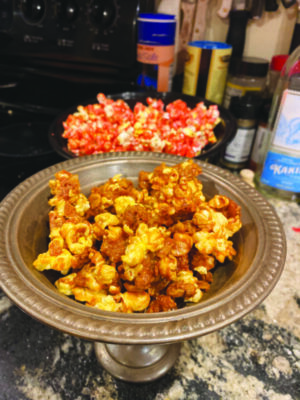
Preheat oven to 250°F. Mix granola and popcorn together in a large bowl, and set aside. Lightly oil a large wooden spoon or a silicone spatula.
Over medium heat, bring corn syrup, chili oil and peanut butter to 235°F; if you are using a candy thermometer, this is the “soft ball” stage, stirring often.
Pour the hot syrup over the popcorn mixture, stirring to coat thoroughly. Turn the sticky mixture out onto a baking sheet with parchment paper or a silicone baking mat.
Bake for one hour, stirring every 15 minutes. Remove the pan from the oven, and set aside until the pan is cool to the touch. Break the popcorn mix into clusters, and store in an airtight container.
Variation: Before baking, you can pack the mixture into parchment-lined baking pans, and bake for the full hour without stirring. Before it has cooled completely, use a sharp knife to cut into bars.
Raised Eyebrows Popcorn Balls
Offer one of these excellent popcorn balls to a friend, they will take a bite, pause, take a second bite, then look thoughtfully at you with raised eyebrows, completely reassessing your potential. These popcorn balls offer a nearly perfect ratio of sugar, salt, butter, peanuts, and of course corn. I adapted a recipe from the Food and Wine website with changes in some of the ingredients.
- 20 cups (around 200 g) movie-style popcorn
- 4 cups (124 g) Corn Chex cereal
- 1½ cups (225 g) dry roasted peanuts
- 3 cups (595 g) sugar
- 1½ cups (468 g) light corn syrup
- ½ cup (1 stick) butter
- ½ cup (120 g) water
- 1 glug (1 to 1 1/2 teaspoons) vanilla
- 1 Tablespoon sea salt
- 1 teaspoon chipotle chili powder
In a very large, lightly oiled bowl, combine the popcorn, peanuts and cereal. Set aside.
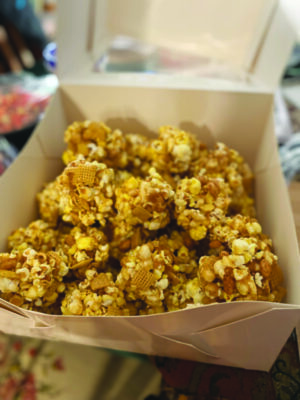
In a saucepan, combine sugar, corn syrup, butter, and water, and cook over medium-low heat until it reaches 295°F (“hard crack” stage), stirring occasionally. When the sugar syrup has come to temperature, stir in the vanilla, salt and chili powder.
Pour the hot sugar mixture over the popcorn, cereal and peanuts, and mix to combine with a lightly oiled wooden spoon or silicone spatula. Most of the peanuts will have fallen to the bottom of the bowl, so take care to flip the caramel corn over once or twice while you stir, to make sure they are incorporated.
With lightly oiled hands, or lightly oiled gloved hands, break off 2- to 3-inch blobs of the popcorn mixture, gently shape them into balls, and place them on a baking sheet covered with parchment paper or a silicone mat. You will have to work fast — the caramel will be very hot, so you’ll have to let it cool a little, but will also be in a race to form the balls before the mixture sets up too much. You will end up with 30 or so balls.
Store these in an airtight container for three or four days, but they are best on the first day, when the popcorn is still crisp.
Popcorn Vodka
Popcorn has a distinct flavor that lends itself to infusing into alcohol. Vodka is a good choice for this, because it is generally neutral in flavor and will let the taste of the popcorn shine through.
popcorn – either freshly popped or movie-style from the supermarket or even from a movie theater
1 bottle of vodka – because you will be infusing it with a flavor that would overwhelm any subtleties in the vodka, a mid-range vodka will be best for this; I like Gordon’s or Mr. Boston. Avoid the very cheapest vodka, which might have off-flavors and taste chemically.
You know that hole in the lid to your blender that you’ve always wondered about? You finally get to use it. Pour the vodka into the jar of your blender, and add about an equal amount — by volume — of popcorn. Put the lid on the blender, and blend the popcorn and vodka together on the lowest setting. Once the initial popcorn has been pulverized, go ahead and add more through the hole in the lid, a handful at a time. Stop from time to time, to check on your progress.
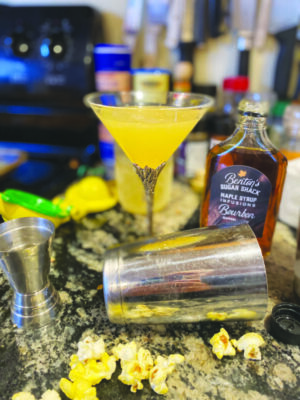
When the popcorn fragments and the vodka seem to take up the same amount of space, pour the mixture off into an airtight container, and put it somewhere cool and dark for two to three days, shaking it occasionally.
After the vodka and popcorn have had time to get to know each other, pour the mixture through a fine mesh strainer, then through a coffee filter in a funnel, into an empty bottle — maybe the original one that the vodka came in, labeled with the date and a short description, so in a couple of weeks, when you find a faintly yellow bottle of alcohol, you’ll remember what’s in it.
Variation: If you’re an impatient sort of person, you can speed the infusion process up by putting your airtight container in a hot water bath. Let it soak at 150°F for two hours, then strain and filter, as above. This is an excellent use for a sous vide, if you have one. Be aware that if you use actual movie theater popcorn for this hot water bath technique, your final product will be a golden yellow color, from the artificial color the theater or supermarket uses in its “butter.”
A cocktail for your Popcorn Vodka: A Caramel Corn Daisy
- 3 ounces popcorn vodka (see above)
- 1 ounces fresh squeezed lemon juice
- 1/2 ounce maple syrup, the darkest you can find – the darker the syrup, the more mapley it will taste
Combine all ingredients over ice in a cocktail shaker. Shake thoroughly, and strain over fresh ice in a rocks glass.
Maple and lemon are the dominant flavors in this drink, with the popcorn bringing up the rear, leaving you with a subtle popcorn flavor between sips.
Cinnamon Caramel Corn
This fire truck red corn gets its flavor and color from hot cinnamon candies. This is another recipe adapted from Bob’s Red Mill with the addition of some Szechuan pepper.
- 8 cups (around 200 g) freshly popped or movie theater-style popcorn
- A 9-ounce (255 g) box of “hot” cinnamon candy (like Hot Tamales or Atomic Fireballs)
- 2 cups (237 g) light corn syrup
- 2 teaspoons Szechuan peppercorns, crushed
Preheat oven to 250°F. Cover a baking sheet with parchment paper or a silicone baking mat.
Measure the popcorn into a large bowl, and set aside.
In a medium saucepan, cook the cinnamon candies, corn syrup, and Szechuan pepper to 235°F; stirring often. When it has come to temperature, pour the mixture over the popcorn, and stir to combine with a lightly oiled silicone spatula. The candy will set up quickly, so this requires haste.
Spread the cinnamon corn on your baking sheet, and bake for an hour, stirring every 15 minutes. Remove from the oven to cool, then break into small pieces.
The flavor of this popcorn is much as you’d expect. It tastes like cinnamon candies. The surprise is in its texture. Baking it has made the popcorn crispy, which contrasts with the toffee-like chewiness of the candy coating. Milk and cookies are a classic to leave for Santa; this, paired with a caramel corn cocktail, could be an alternative.
Miso Caramel Popcorn
Miso is a fermented soybean paste. Its salty, funky nature provides a good counterpoint to the sweetness of caramel. The original recipe is adapted from a recipe on the Food and Wine website.
- 9 cups (90 to 95 g) freshly popped or movie-style popcorn
- 6 Tablespoons (1½ sticks) butter
- ½ cup (99 g) packed brown sugar
- ¼ cup (4 Tablespoons or 60 g) white miso
- 2 Tablespoons light corn syrup
- 1 teaspoon toasted sesame oil
- sea salt
- ½ teaspoon baking soda
- 3 Tablespoons sesame seeds
Measure popcorn into a large plastic or glass bowl, and set aside.
Toast the sesame seeds in a dry pan over medium-low heat, stirring or tossing continuously. They will deepen in color and release a nutty flavor. As soon as the seeds have darkened to a tawny color, like a lion, transfer them immediately to a plate to cool. If you keep them in the pan, they will continue to cook and might burn.

In a small saucepan, combine the butter, brown sugar, miso, corn syrup, sesame oil, and ½ teaspoon of salt. Cook over medium-low heat until the butter has melted and the mixture is bubbling. Whisk in the baking soda. This will make the caramel foam up; it’s supposed to.
Pour the miso caramel over the popcorn, and stir to combine with a lightly oiled silicone spatula. Add the sesame seeds you toasted earlier, and stir it again.
Place the bowl in your microwave, and cover it with a paper towel, to keep any splatter contained. Any drops of caramel that splash onto the sides or ceiling of your microwave will bond there like industrial concrete.
Cook the popcorn in your microwave for 1½ minutes.
Turn the popcorn out onto a baking sheet covered with parchment paper or a silicone mat, and sprinkle with more salt. Allow it to cool for 15 minutes before breaking it into pieces and serving.
French Onion Popcorn
This combines the best of two classic snacks, popcorn and chips and dip.
- 8 cups (80 to 90 g) freshly popped or movie-style popcorn
- 6 Tablespoons (¾ stick) butter, melted and cooled
- 1 ounce dry onion soup mix (about half a standard 2-ounce packet)
This is about as simple as it gets. It hardly seems fair to call this a “recipe.”
Measure the popcorn into a large bowl.
Pour the melted butter over it, stirring to combine.
Sprinkle half the soup mix over the popcorn and stir to combine, then repeat with the remaining soup mix. Serve with beer, or better yet, Champagne.


